If you wanted the fastest two-stroke 250cc race-replica, you chose Kawasaki’s KR-1 or later KR-1S. Andy Bolas rides a mint example of the 1989 UK model KR-1.
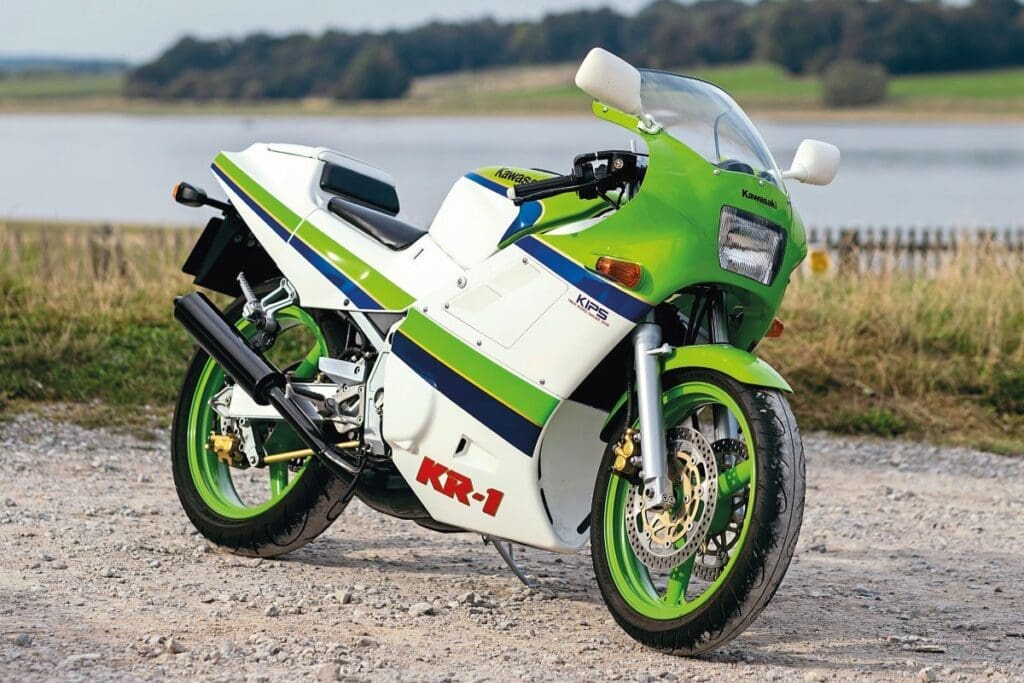
Words: Andy Bolas Pics: Gary Chapman, Mortons Archive
By early 1983 the 250 learner market was no more than a memory and the then current 250cc machines were not worth much at all.
While many mourned their passing, you could see where the Government was coming from as 17-year-olds were throwing their almost 100mph-capable two-stroke RDs, KHs and X7s up the road and often injuring themselves in the process…
This ban on 250cc learner bikes coincided with Suzuki launching the RG250 Gamma Mk.1, which was the first production bike to utilise an alloy frame, and also looked like a proper racer for the road thanks to its half-fairing. This bike was a real yardstick for the class and it could be argued that this was where the 250cc tech race began.
As the years rolled by each manufacturer wound up the ante and by the end of the 1980s the 250cc two-stroke was no longer a class of machines suitable for the novice rider, but more something akin to a racer for the road and to be enjoyed by riders with more experience. After all, by now they were pumping out around 60bhp and were around a featherweight 130 kilos. If you’re the same age as me, this was the most exciting time of our motorcycling lives, as most people would have a two-stroke 250 or moving into the 1990s a four-stroke 400 like the NC30 or ZXR400 after passing their test. Buzzy, high-revving two and four-stroke race replicas – what’s not to like?
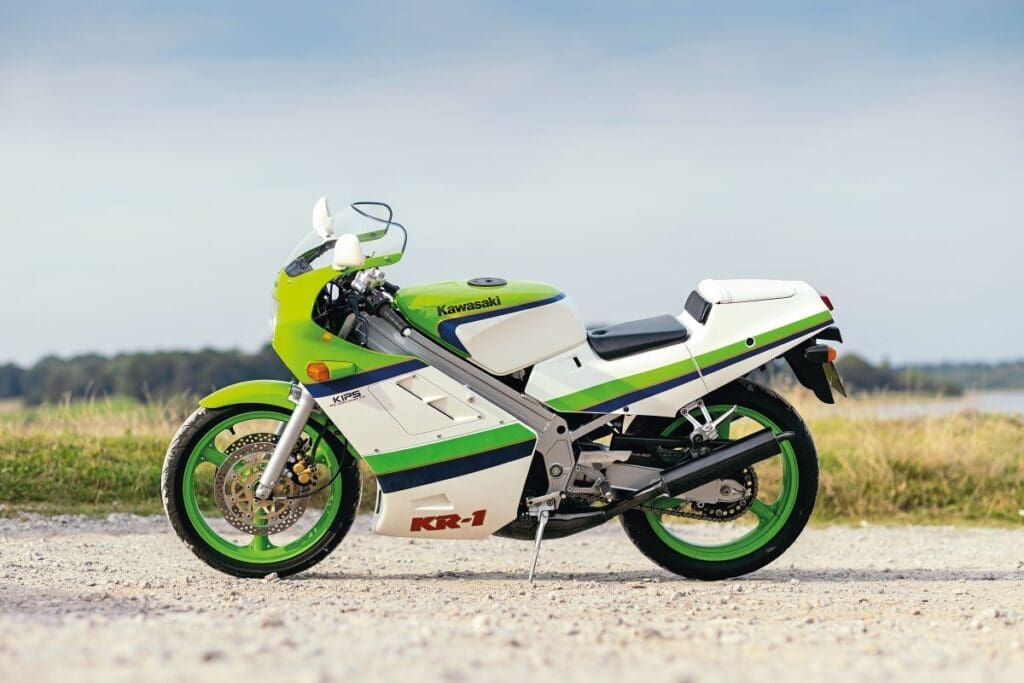
When Kawasaki introduced the KR-1 into the UK in 1989 (model code KR250 B2) it more or less immediately cleaned up in the club racing scene. Certainly it had the legs on the parallel twin TZR250 2MA that had been the go-to bike for budding racers for a couple of years. The KR also was showing Suzuki’s new RGV250K the way home. These on-track antics would have boosted sales a little if only to the proddie racers wanting the fastest bike out there.
Looks-wise, both bikes had their own pros and cons. The KR looked a little bulbous and square-edged compared to the sharper-looking RGV. However, the KR also was roomier compared to the racier-looking Suzuki.
The KR-1 looked fast even sat in the Kawasaki dealer’s showroom. It had a beefy alloy frame, which already had a lug welded on to it ready for the fitting of a steering damper; 41mm forks; a sturdy alloy swingarm; clip-on bars which were mounted below the top yoke; and separate seat provision for the rider and pillion – if you were that desperate to carry a pillion, of course. The pillion provision did have some useful pull-out bungee hooks underneath, though. The KR-1 was best for solo missions where you could bury your head behind the fairing and look at those sparse clocks.
Kawasaki always had a bit of a reputation for building stonking motors and the KR-1 was no exception; if you got a good one you would have an absolute missile. Unfortunately build quality for the engines back in the day was a little hit and miss. Issues included barrels being different heights and ring locating pegs going AWOL, and these would score the nikasil coating on the alloy barrels, meaning you would at least need a cylinder replate and new pistons and rings.
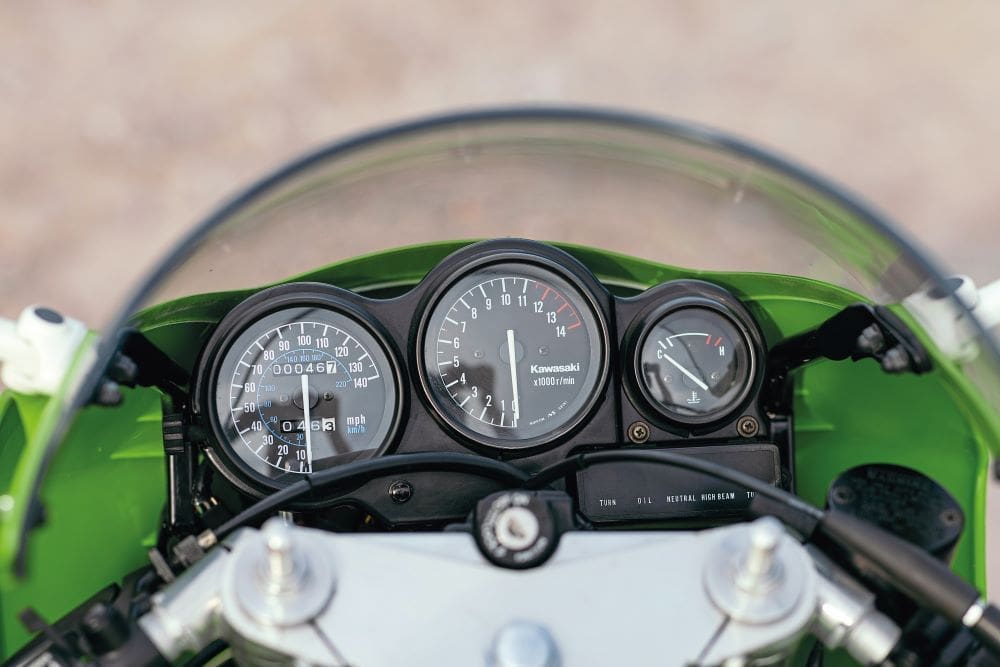
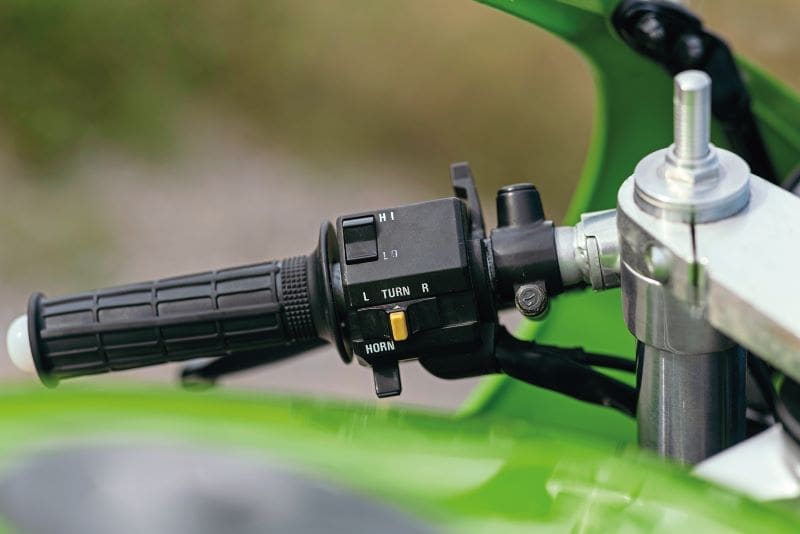
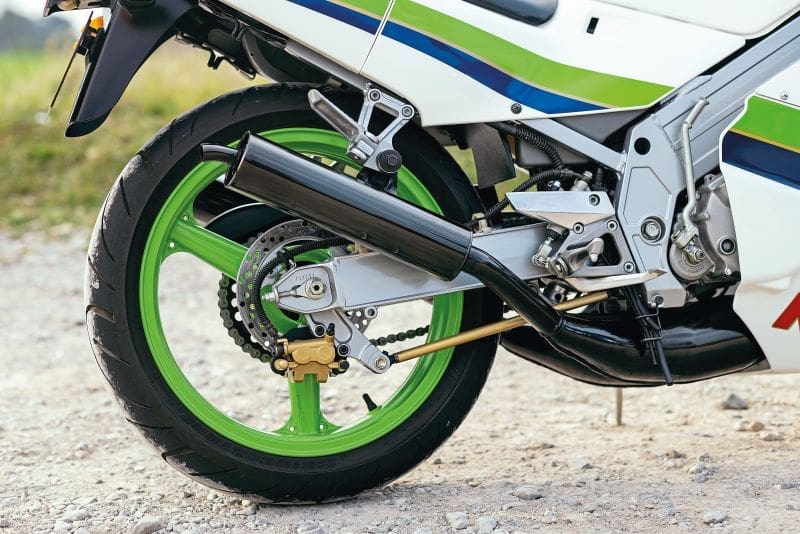

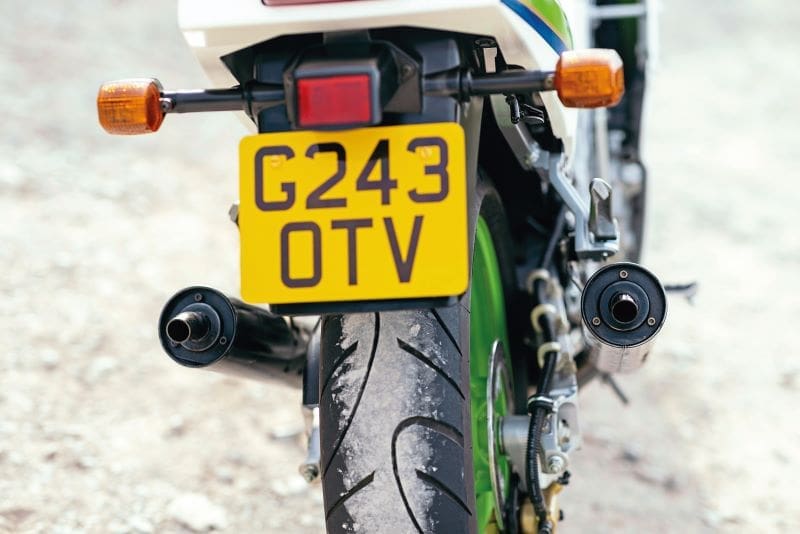
The 249cc motor has a bore and stroke of 56 x 50.6 with a compression ratio of 7.4:1, making around 57bhp @ 10,500rpm and 27lb-ft of torque @ 10,500 rpm; also you get about 1000 revs over-rev which is nicer than hitting a brick wall rev-limiter on the RGV. These figures were not to be sneezed at back in 1989. Kawasaki also fitted KIPS (Kawasaki Integrated Power Valve System) on the KR to help boost its bottom-end and mid-range without sacrificing the top-end power.
The motor is fed by two 28mm Keihin flat-slide carbs. The KR-1 has slightly smaller pilot jets than the later KR-1S and this stops the low-down bogging just off idle that the first models can suffer from. That’s progress for you.
Running gear on the KR is pretty beefy for the age, with a hefty box section alloy swingarm attached to the frame by a rear shock which is adjustable for pre-load and rebound damping to keep the rear 18-inch wheel in check; the front-end features 41mm forks adjustable for pre-load only and a more traditional 17-inch wheel.
The brakes were amazing back in the day and are pretty good as it goes today, too. One of the benefits of the bike weighing less than 130 kilos dry is that they don’t have a hard job to do. With a quite steep steering head angle and short wheelbase, the KR can change direction on a whim; the downside to this is that it normally has an adverse effect on the stability of the bike and the little KR is no exception. The B2 model even comes with a lug on the frame ready to attach a steering damper to.
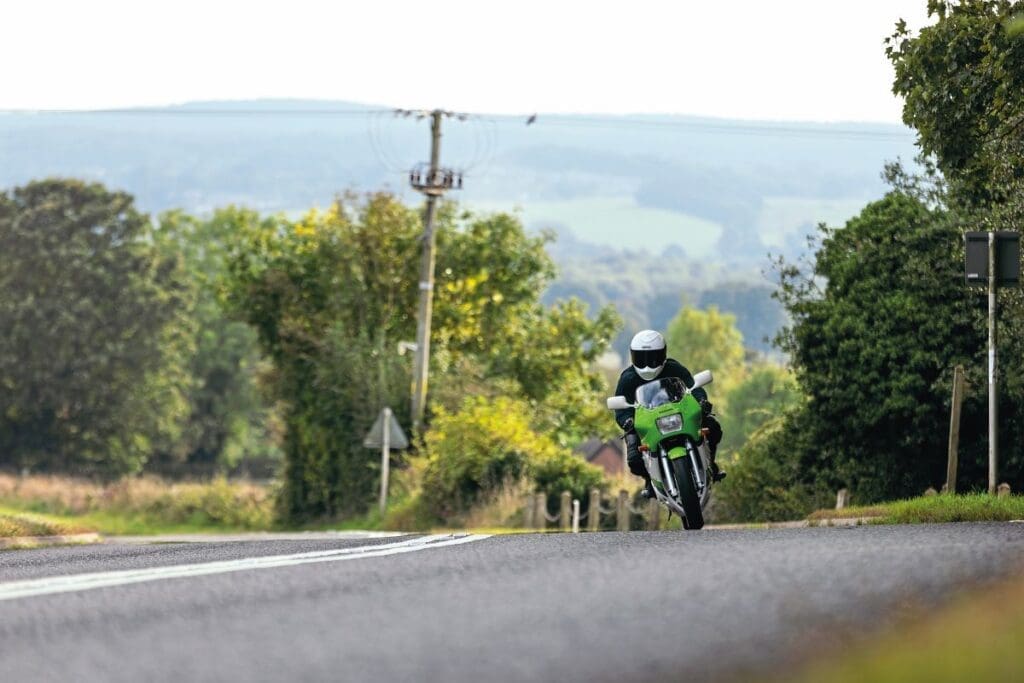
Make no mistake, the KR was a racer for the road, with little or no thought given to practicalities or unnecessary equipment, although its engine does seem more tractable and useable than the RGV on the road.
Right, enough waffle, let’s take a look at our test bike, which has undergone extensive restoration and looks almost as good as when it rolled out of the showroom in 1989. The engine is fresh, and everything still needs bedding in. The rear tyre looks a little too big for the rim but it is a struggle now to get decent tyres in the standard 130/60/18 so you end up with a 150. I have since managed to get some Dunlops in a 140-section from Japan in a group buy on the KR-1S Facebook page which I may fit to this bike. Looking around the bike and everything is very functional. The choke is bar mounted so no fumbling around by the carbs; the fuel tap is easy enough to get to and switch to reserve even when you’re on the move. The clocks are very racer-like with a few idiot lights, and the dials are easy to see and read. The mirrors are almost useful which, on a bike like this, is a revelation as usually you just get to see your elbows and bits of the smoke trail you have just laid down behind you!
I like the riding position of the KR as it is a little roomier than the RGV and also the pegs are in a good position for me. The bike is easy to start and once off choke sounds very crisp and healthy – if a little smoky. The KR pulls away without any dramas or mad clutch slipping to get drive. Once you hit around 5000rpm things start to move along a bit, then at 7000rpm things really wake up with another bit of a step at 8000rpm. Unfortunately that’s as far as we are going with this bike as the engine has only done a handful of miles. This bike carburates so smoothly and the throttle response is near instant. Cruising along at 7000rpm in top gear shows an indicated 90mph (on a private road, of course); rolling the throttle on, the KR just pulls and pulls and feels so willing. I have to roll off as I realise I’m still running-in the engine and don’t want to cause myself any issues.
The handling is spot on and the KR changes direction so easily by just moving around and counter steering; that new rear shock from Hagon is doing a sterling job back there. Where things do get a little flighty are when you are accelerating over less-than-smooth surfaces; this can prompt a little waggle of the bars, not enough to go into a proper full-on lock-to-lock tank slapper, but I guess it could if we were able to use full throttle. I have heard stories back in the day of people having major lock-to-lock tank slappers on KR-1s to the point that the pistons had gone back in the calipers and the brakes needed the lever to be pumped to get the brake back!
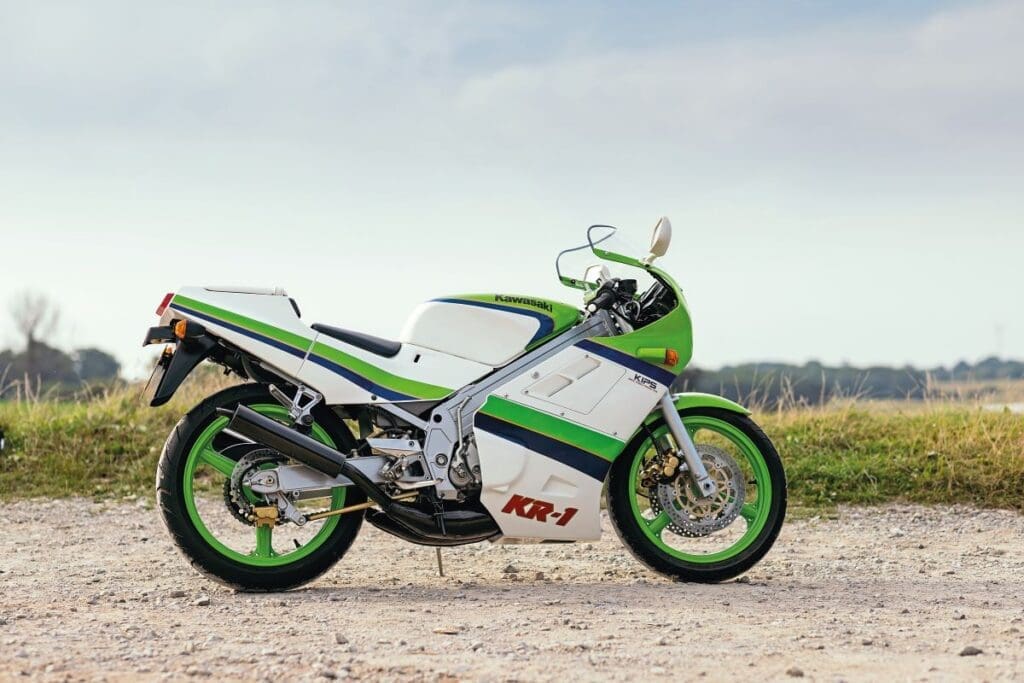
Talking of brakes, these are blindingly sharp and you wouldn’t think that they could be improved until you ride a KR-1S with its four-piston Tokico calipers. The KR-1 has twin-piston sliding calipers gripping on to two 280mm semi-floating discs which do an amazing job of hauling the bike up from any speed with plenty of bite and feel, and the rear is sharp with less feel and progression than the front brake.
The whole package is well suited to back-lane scratching with its sharp-handling chassis and eye-bulging brakes coupled with that screaming parallel twin motor. It makes A and B roads a complete blast; you can see why back in the day they had a giant-killing reputation. I imagine many 750s suffered at the hands of well-ridden KRs.
All-in-all the KR-1 is a cracking package and is one of my favourite 250s ever. There is a very helpful and active Facebook page with lots of people willing to help with advice if you’re having issues and, importantly, getting parts remanufactured or discounts on group buys. Check them out on Facebook Kawasaki KR1-S. Also, Paul Bartley is very knowledgeable and helpful, and he has compiled a list of parts which have been remanufactured or superseded parts to keep these bikes on the road. A while ago if you needed KIPS valve or crank parts you would struggle to find the bits you needed but places like BDK and 2T engineering can more or less help with everything you will need.
Our test bike was lovingly restored by its previous owner but not used on the road. I have had a few little issues getting the bike ready for our road test but nothing major and the bike is running fantastically well now. As the bike had around 10 miles on its NOS speedo, I thought it best to take it out a few times before we had an audience.
Anyway, Ella volunteered to ride the bike to the MoT station which she did and happily the bike passed, although by the time she got back the rear shock had expired.
A quick call to the legend that is Tony Hutchison at Hagon saw a new shock with us for the next day and we immediately fitted it, so the bike was ready to roll. So big thanks to Hagon and Tony for helping us out in the 11th hour.
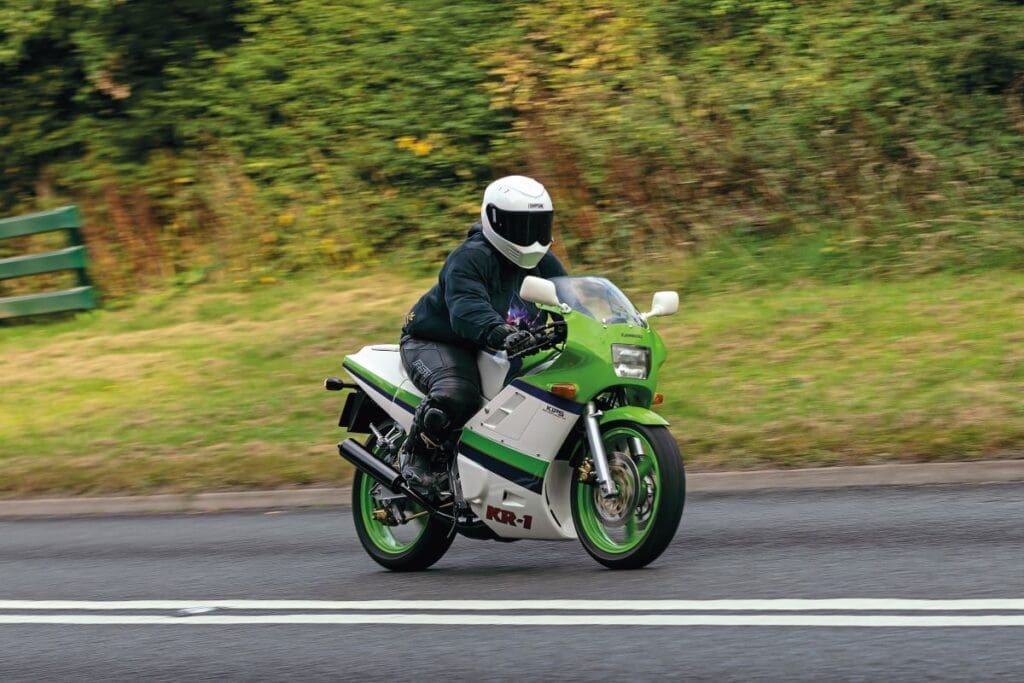
Workshop view: Simon Pinfield
“I used to work at PW Ranger in Stafford back in the late 1980s and early 90s in both sales and the workshop. So not only was I selling the KRs, I was also fixing them and at the weekends I used to race a KR-1. The KR-1 wasn’t without its issues: base gaskets, ring locating pegs and generators spring to mind, but if you got a good one they were pretty robust. My race bike was run-in on the road, then had minimal maintenance over its first season and remained in standard tune for the season, too. Out of the crate, the KR was both faster and better handling than my TZR250 2MA which was a Terry Becket-tuned missile and the standard KR made it feel pedestrian. Overnight almost, the grid changed from TZRs and Mk.3 Gammas to KR-1s. There wasn’t an RGV that could live with my KR around Darley Moor. In 1990 when the KR-1 was replaced with the KR-1S it was a revelation again and did everything a little better than the KR-1, but I felt the S was a little more fragile; brilliant bikes and a great era in general for motorcycling.”
Second opinion: Ella Middleton

“I have ridden various 250 two-strokes and have my own 2MA TZR track bike along with a TDR250. I wasn’t overly impressed with the KR-1 to begin with, but I think this was mainly due to being restricted on revs. It’s like just as the motor is coming on song and starting to come into the powerband I’m having to change up. I have, however, ridden a B1 with a few miles on it and can confirm they do go really well and are a fair bit quicker than my old TZR. The riding position is very much like a reverse cylinder TZR, only the KR-1 feels lighter and less peaky. I like the fact that on the B1 you could run into bends leaving it to the last minute, knock it down a gear over-revving slightly, put the bike on its side, then be ready to come out the other side of the bend on the power, whereas on the RGVs I have ridden you don’t have that as you just hit a brick wall with the rev-limiter. I feel I can be a little careless on a KR. I love the handling, although the oversize rear tyre isn’t doing it any favours. It just feels odd but Andy did warn me about this. Also it feels like you can push and push going harder and harder but I get the impression when the bike does let go you’re not going to get much warning prior to proceedings!”
SPECIFICATION
Engine type: Two-stroke parallel twin with KIPS
Capacity: 249cc
Bore x Stroke: 56 x 50.6mm
Compression ratio: 7,4:1
Induction: Reed-valve
Cooling system: Liquid
Carburation: 2 x Keihin PWK 28 carbs
Ignition: Capacitor discharge
Transmission: 6-speed chain driven
Frame type: Box section aluminium diamond construction
Suspension, front: 41mm forks with pre-load adjustment
Suspension, rear: Uni-Trak, with rear shock adjustable for pre-load and rebound damping
Front tyre: 100/70/17
Rear tyre: 130/60/18
Brakes, front: 2 x 280mm semi floating discs with twin-piston calipers
Brakes, rear: Single 200mm disc with twin-piston caliper
Length x width x height: 2015mm x 690mm x 1115mm
Wheelbase: 1365mm
Rake/trail: 24 degrees/93mm
Seat height: 750mm
Fuel capacity: 16 litres
Dry weight: 123kg
Max power: 55bhp @10,500rpm
Max torque: 27lb-ft @ 10,500rpm



